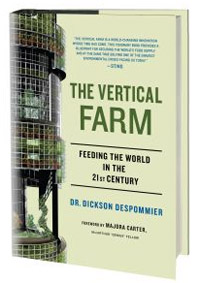Thanksgiving is such a great holiday. As I prepare to sit down to two family meals today, I’d like to thank all the farmers out there who work so hard to produce my food. I’m also thankful to the researchers in land-grant universities and many extension agents for their vital contributions. Also, to all the tractor and combine companies out there. I’m even thankful for the big, “evil” seed and chemical conglomerates. What a bounty they provide us!
There probably aren’t many who are thinking what I’m thinking.
Today, our world and culture are divorced from the soil. We don’t know what it means to plant with hope, to wait for rain, to weed, prune or harvest. So even at Thanksgiving, most Americans are either oblivious to agriculture or even worse, they are hostile to it.

Here’s an example of an “un-thankful turkey” I stumbled across. Have you heard of “vertical farming?” Dickson Despommier, a professor at Columbia in NYC, has written a book called The Vertical F arm: Feeding the World in the 21st Century. According to the Vertical Farm Project website, this concept “has excited scientists, architects, and politicians around the globe.” I notice that they make NO MENTION of excited farmers, horticulturalists or anyone with any knowledge of agriculture.
arm: Feeding the World in the 21st Century. According to the Vertical Farm Project website, this concept “has excited scientists, architects, and politicians around the globe.” I notice that they make NO MENTION of excited farmers, horticulturalists or anyone with any knowledge of agriculture.
The basic idea is that agriculture is dysfunctional and unable to meet the future needs of our world. Despommier isn’t thankful to our farmers or the agriculture industry. He proposes that we abandon the concept of the family farm and build massive skyscrapers in urban locations to grow our food hydroponically and organically.
Most of us could poke a lot of holes in this idea, but it’s already been done for us. Check out this interview of the author on the Colbert Report:
| Dickson Despommier | |
Pretty funny, but consider that Colbert’s act is to mock things that he and his audience agree with. Here’s the lesson I take away: an alarming number of intelligent leaders in the fields of education, politics, economics, planning, design and architecture do not understand our world of farming. They think agriculture essentially rapes and poisons the earth. Their ideal world would be one without farms, without tractors, without pesticides, fertilizers, and overhead irrigation.
I wish we could laugh this “vertical farming” off, but I have a feeling the philosophy at its heart will persist.
There are many things going on right now that we are inclined to ignore or dismiss. With “Plants vs Zombies” I was trying to point out that a game we think is irrelevant actually reveals our own irrelevance to the current culture. With “Vertical Farming” I want to suggest that when it comes to solving future agricultural/horticultural/environmental issues we are not seen as having solutions…in fact, many think we are the problem!
~Art
PS: I haven’t actually read the book. Think I should?
PPS: One last comment. Think this topic isn’t on anyone’s mind? Go to Google. Type in “farm.” Click “images” on the left-hand column. What I find is that two of the images are of concepts for this “vertical farming.” I believe that this idea is on someone’s mind.
